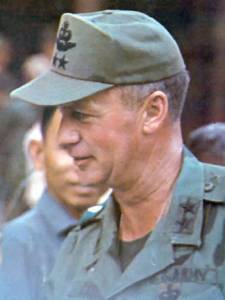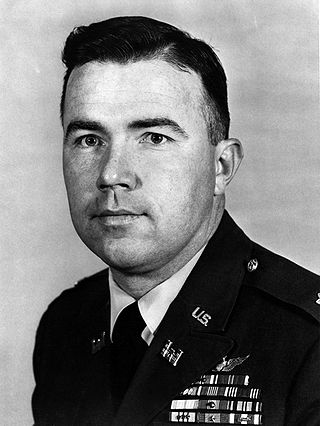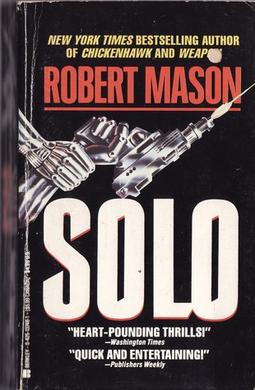
The Bell UH-1 Iroquois is a utility military helicopter designed and produced by the American aerospace company Bell Helicopter. It is the first member of the prolific Huey family, as well as the first turbine-powered helicopter in service with the United States military.
Chickenhawk is a political term used in the United States to describe a person who is a war hawk yet actively avoids or avoided military service when of age. In political usage, chickenhawk is a compound of chicken and hawk from war hawk. Generally, the implication is that chickenhawks lack the moral character to participate in war themselves, preferring to ask others to support, fight, and perhaps die in an armed conflict.

USS Iwo Jima (LPH-2) was the lead ship of her class and type and the first amphibious assault ship to be designed and built from the keel up as a dedicated helicopter carrier. She carried helicopters and typically embarked USMC elements of a Marine Amphibious Unit (MAU)/later Marine Expeditionary Unit (MEU) principally the Aviation Combat Element (ACE) to conduct heliborne operations in support of an amphibious operation. There was no well deck to support landing craft movement of personnel or equipment to/from shore. Iwo Jima was the second of three ships of the United States Navy to be named for the Battle of Iwo Jima, although the first to be completed and see service.

Jesus nut is a slang term for the main rotor retaining nut or mast nut, which holds the main rotor to the mast of some helicopters. The related slang term Jesus pin refers to the lock pin used to secure the retaining nut. More generally, Jesus nut has been used to refer to any component that is a single point of failure which results in catastrophic consequences, and the only thing left to do is, metaphorically speaking, pray to Jesus, hence the name.

Marine Light Attack Helicopter Squadron 367 (HMLA-367) is a United States Marine Corps helicopter squadron consisting of AH-1Z Viper attack helicopters and UH-1Y Venom utility helicopters. Originally commissioned during World War II, the squadron participated in combat operations on Peleliu and Okinawa. Reactivated during the Vietnam War, the squadron has served during numerous conflicts since. The squadron is based at Marine Corps Air Station Camp Pendleton, California and falls under the command of Marine Aircraft Group 39 (MAG-39) and the 3rd Marine Aircraft Wing.

George William Casey Sr. was a United States Army major general who was killed in a helicopter crash in July 1970, in South Vietnam. General Casey, who had served in the Korean War, was in command of the US 1st Cavalry Division at the time of his death. His son George W. Casey Jr. served as the 36th Chief of Staff of the United States Army from April 2007 to April 2011.

Weapon is a 1989 science fiction novel by Robert Mason. The book was Mason's first novel; he had previously written a memoir about his experiences in Vietnam titled Chickenhawk. The book is about an android, designed to kill, which experiences a crisis of conscience and runs away from its government masters to live in a Nicaraguan village.

Bruce Perry Crandall is a retired United States Army officer who received the Medal of Honor for his actions as a pilot during the Battle of Ia Drang on November 14, 1965, in South Vietnam. During the battle, he flew 22 missions in a Bell Huey helicopter into enemy fire to evacuate more than 70 wounded and bring ammunition and supplies to United States forces. His actions in the battle of the Ia Drang valley were portrayed by actor Greg Kinnear in the Mel Gibson film, We were soldiers. By the end of the Vietnam War, he had flown more than 900 combat missions. He retired from the army as a lieutenant colonel and worked several jobs in different states before settling down with his wife in his home state of Washington.

The Bell UH-1N Twin Huey is a medium military helicopter designed and produced by the American aerospace manufacturer Bell Helicopter. It is a member of the extensive Huey family, the initial version was the CUH-1N Twin Huey, which was first ordered by the Canadian Forces in 1968.

John C. "Doc" Bahnsen, Jr. is a retired United States Army brigadier general and decorated veteran of the Vietnam War.

Robert C. Mason is a Vietnam War veteran and author of several books, including his first, best-selling memoir: Chickenhawk (1983). Mason piloted Huey "Slicks" in the United States Army as a Warrant Officer 1. He sailed to Vietnam with the 1st Cavalry Division (Airmobile) and served a one-year tour, nine months with the "First Cav", the last three months with the 48th Aviation Company.

The Bell UH-1 Iroquois military helicopter, first introduced in 1959, is the first production member of the prolific Huey family of helicopters, and was itself developed in over twenty variants, which are listed below.

Air Marshal Sir Alister Murray Murdoch, was a senior commander in the Royal Australian Air Force (RAAF). He served as Chief of the Air Staff (CAS) from 1965 to 1969. Joining the Air Force in 1930, Murdoch trained as a seaplane pilot and participated in an Antarctic rescue mission for lost explorers in 1935. During World War II, he commanded No. 221 Squadron RAF in Europe and the Middle East, and later occupied senior positions on the staff of RAAF formations in the South West Pacific. His post-war appointments included Commandant of RAAF College from 1952 to 1953, Air Officer Commanding (AOC) Training Command from 1953 to 1955, Deputy Chief of the Air Staff from 1958 to 1959, and AOC Operational Command from 1962 to 1965.

The 17th Aviation Brigade was a military formation of the United States Army. It was originally activated at Nha Trang, Vietnam, as the 17th Aviation Group (Combat) on 15 December 1965 under the 1st Aviation Brigade. Later it moved to Tuy Hoa in November 1970 and then to Pleiku in January 1972. The group had the mission of commanding and controlling all non-divisional assets in II Corps Tactical Zone, under I Field Force. The 10th, 14th, 52d, 223rd and 268th Aviation Battalions as well as the 7th Squadron, 17th Cavalry served with the group.

Solo is a 1993 science fiction novel by Robert Mason. The book was Mason's second novel; he had previously written Weapon and a memoir about his experiences in Vietnam titled Chickenhawk.

Camp Radcliff is a former United States Army base in the An Khê District in central Vietnam.

Charles Seymour Kettles was a United States Army lieutenant colonel and a Medal of Honor recipient.

Alan "Ace" Cozzalio was an American army officer, primarily known for his distinguished service as a helicopter pilot in the Vietnam War. Initially nominated for the Medal of Honor, he instead received the Distinguished Service Cross as well as every lesser commendation of valor. He remained in the army, rising to the rank of Lieutenant colonel before being medically retired due to heart problems. He died six years later at the age of 46 after an unsuccessful heart transplant operation.
Lieutenant Colonel Hugh L. Mills Jr. is a retired United States Army officer who served in the Vietnam War.

















